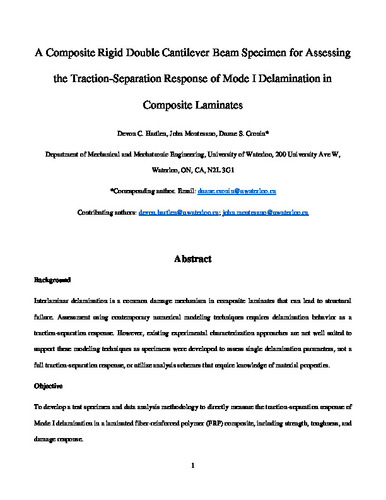| dc.contributor.author | Hartlen, Devon | |
| dc.contributor.author | Montesano, John | |
| dc.contributor.author | Cronin, Duane | |
| dc.date.accessioned | 2023-10-03 17:43:37 (GMT) | |
| dc.date.available | 2023-10-03 17:43:37 (GMT) | |
| dc.date.issued | 2023-01-16 | |
| dc.identifier.uri | https://doi.org/10.1007/s11340-023-00987-2 | |
| dc.identifier.uri | http://hdl.handle.net/10012/20018 | |
| dc.description | This is the Preprint of Hartlen, D. C., Montesano, J., & Cronin, D. S. (2023). A composite rigid double cantilever beam specimen for assessing the traction–separation response of mode I delamination in composite laminates. Experimental Mechanics. The Version of Record is available at https://doi.org/10.1007/s11340-023-00987-2 © Society for Experimental Mechanics 2023 | en |
| dc.description.abstract | Background
Interlaminar delamination is a common damage mechanism in composite laminates that can lead to structural failure. Assessment using contemporary numerical modeling techniques requires delamination behavior as a traction–separation response. However, existing experimental characterization approaches are not well suited to support these modeling techniques as specimens were developed to assess single delamination parameters, not a full traction–separation response, or utilize analysis schemes that require knowledge of material properties.
Objective
To develop a test specimen and data analysis methodology to directly measure the traction–separation response of Mode I delamination in a laminated fiber-reinforced polymer (FRP) composite, including strength, toughness, and damage response.
Methods
The proposed composite Rigid Double Cantilever Beam (cRDCB) specimen is comprised of a [0]_4 unidirectional E-glass/epoxy laminate co-cured to rigid metallic adherends. Traction–separation response was assessed directly from measured force and displacement behavior using a closed-form analysis scheme that does not require a priori knowledge of composite material properties. Standard double cantilever beam (DCB) tests were performed for comparison.
Results
The cRDCB specimen captured early damage initiation and progression in greater detail than the DCB, with measured strain energy release rates agreeing well between the two approaches. The cRDCB also captured the effects of large-scale damage mechanisms such as fiber bridging. The measured traction–separation responses are suitable for scenarios where prediction of the initiation and early damage response of delamination is important.
Conclusions
Combined with a data processing technique, a single cRDCB test enabled measurement of the full Mode I traction–separation response. In addition, the cRDCB provided high-resolution and could detect early-stage Mode I delamination damage in FRP laminates. The measured traction–separation responses can be directly inputted into cohesive zone models to predict the initiation and progression of Mode I delamination. | en |
| dc.language.iso | en | en |
| dc.publisher | Springer | en |
| dc.relation.ispartofseries | Experimental Mechanics; | |
| dc.subject | delamination | en |
| dc.subject | characterization | en |
| dc.subject | composite laminates | en |
| dc.subject | traction-separation response | en |
| dc.subject | rigid double cantilever beam | en |
| dc.title | A Composite Rigid Double Cantilever Beam Specimen for Assessing the Traction–Separation Response of Mode I Delamination in Composite Laminates | en |
| dc.type | Preprint | en |
| dcterms.bibliographicCitation | Hartlen, D.C., Montesano, J. & Cronin, D.S. A Composite Rigid Double Cantilever Beam Specimen for Assessing the Traction–Separation Response of Mode I Delamination in Composite Laminates. Exp Mech (2023). https://doi.org/10.1007/s11340-023-00987-2 | en |
| uws.contributor.affiliation1 | Faculty of Engineering | en |
| uws.contributor.affiliation2 | Mechanical and Mechatronics Engineering | en |
| uws.typeOfResource | Text | en |
| uws.peerReviewStatus | Unreviewed | en |
| uws.scholarLevel | Graduate | en |

